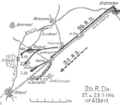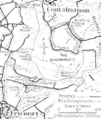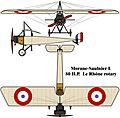Capture of Contalmaison facts for kids
Quick facts for kids Capture of Contalmaison |
|||||||
|---|---|---|---|---|---|---|---|
| Part of the Battle of the Somme, in the First World War | |||||||
 Battle of the Somme 1 July – 18 November 1916 |
|||||||
|
|||||||
| Belligerents | |||||||
| Commanders and leaders | |||||||
| Douglas Haig | General Erich von Falkenhayn | ||||||
| Strength | |||||||
| 4 divisions (parts) | 17 regiments (parts) | ||||||
| Casualties and losses | |||||||
| c. 12,000 | c. 4,000 | ||||||
The Capture of Contalmaison was an important event during the Battle of Albert. This battle was part of the much larger Battle of the Somme in the First World War. Contalmaison is a small village in northern France, located about 4 miles (6.4 km) north-east of Albert. It sat on a hill, giving a great view in all directions, which made it a very important spot for both sides during the war.
In 1914, German troops first captured Contalmaison. By 1916, the village was heavily defended with many trenches and barbed wire. On 1 July 1916, the first day of the Somme battle, British soldiers tried to capture it but faced heavy losses. The fight for Contalmaison continued for several days, with fresh British divisions joining the attack. The village was finally captured by British forces on 10 July 1916. This victory helped the British move closer to the German second line of defense, preparing for the next big attack, the Battle of Bazentin Ridge.
The fighting for Contalmaison was very costly for both sides. The British suffered around 12,000 casualties, and the Germans also lost many soldiers. The village later changed hands again during the war but was finally taken by British forces in August 1918.
Why Contalmaison Was Important
The Village and Its Location
Contalmaison is a small village in the Somme region of France. It's about 4 miles (6.4 km) north-east of Albert. The village sits on a high point, like a small hill, which gave anyone there a clear view of the surrounding area. This made it a very strategic location during the war. In 1914, the village had a church, a château (a large country house), and 72 houses. It was the seventh-largest village in the Somme area.
Early Days of the War (1914)
German forces first captured Contalmaison on 28 September 1914. This happened as part of their advance down the Bapaume–Albert road. German soldiers from the 28th Reserve Division took the village, capturing 20 French prisoners. They lost only three men killed and 21 wounded. After this, the area around Contalmaison became quieter, with only occasional artillery shelling until 1916.
Building Defenses (1915)
In 1915, the German army began building strong defenses across the Western Front. They wanted to create a system that could hold off attacks with fewer soldiers. This included making barbed wire obstacles much wider and taller. They also dug three lines of trenches instead of just one. The first trench was for guards, the second for the main group of soldiers, and the third for local reserves.
Dugouts, which are underground shelters, were made much deeper, from 6-9 feet (1.8-2.7 m) to 20-30 feet (6.1-9.1 m) deep. These dugouts were big enough to hold about 25 men. An extra line of strong points was built about 1,000 yards (910 m) behind the front line. All these changes made the German defenses very tough to break through.
The First Day of the Somme (1 July 1916)
British Attack Plan
On 1 July 1916, the British III Corps planned a major attack. Heavy artillery would fire on German defenses, moving forward in stages. The infantry (foot soldiers) would follow behind a moving wall of artillery fire, called a creeping barrage. This barrage would move slowly, clearing the way for the soldiers.
The 34th Division, on the right side of the III Corps, was given the task of capturing several German positions. Their goal was to advance about 2 miles (3.2 km) and reach a line close to the German second defense line, between Contalmaison and Pozières. This meant they had to capture a fortified village and six German trench lines.
The Attack on 1 July
At 7:30 a.m. on 1 July, the British soldiers of the 34th Division began their advance. However, within ten minutes, about 80 percent of the leading soldiers were killed or wounded. This was because German machine guns, hidden in secret spots, opened fire as soon as the British artillery stopped. Many British soldiers were caught in the open, making them easy targets.
Some British units managed to push forward, even reaching close to Contalmaison. One group from the 16th Royal Scots even got into the village for a short time before being wiped out. But the German defenses were too strong, and the British suffered huge losses. The 34th Division alone lost 6,380 men, which was the highest number of casualties for any division that day.
The Battle for Contalmaison (2–10 July)
British Preparations (2–6 July)
After the first day's heavy losses, British commanders decided to keep pushing towards Contalmaison. On 2 July, General Douglas Haig, the British commander, wanted to use the success on the right side of the battle to advance towards the German second line.
Over the next few days, British forces continued to attack nearby woods and trenches to clear the way to Contalmaison. On 3 July, the 17th (Northern) Division and 21st Division attacked and captured Bottom Wood and Shelter Wood. This was a tough fight, but the British captured many German prisoners.
Rainstorms from 3 to 6 July made the ground muddy and difficult for soldiers and equipment. Despite the bad weather, British artillery continued to bombard German positions. Engineers worked to repair roads and railways to bring supplies forward. British intelligence believed the Germans were weakened, and a big attack could succeed.
German Defenses (2–6 July)
While the British were attacking, the Germans were also bringing in fresh troops to defend their lines. The 3rd Guard Division was quickly moved to the area to replace the exhausted German divisions. They held strong positions, especially the Kaisergraben (Emperor Trench), which was a key defense line across Contalmaison Spur. This trench had barbed wire and deep dugouts.
On the night of 6/7 July, the 183rd Division began to take over from the Guard Division. The new German troops found that their defenses had been badly damaged by British shelling. Many dugouts were blocked, and soldiers had to lie in the open, suffering more casualties from British artillery.
Fighting on 7 July
The British launched another attack on Contalmaison in the early morning of 7 July. The 17th (Northern) Division attacked after a 35-minute bombardment. However, the German wire was still intact, and machine-gun fire stopped the British advance. Some British soldiers managed to get into Pearl Alley and even Contalmaison itself, but they were soon pushed back by German counter-attacks.
Later that day, the 23rd Division attacked Contalmaison. Despite heavy machine-gun fire, some troops managed to get into the village, reaching the church and taking prisoners. But they ran out of ammunition and had to withdraw later in the afternoon. The mud and heavy German shelling made it very difficult for the British to continue their attacks.
Fighting on 8–9 July
On 8 July, British patrols found Contalmaison and nearby Bailiff Wood still strongly held by the Germans. Another British attack on the village that evening was stopped by intense machine-gun and artillery fire. German counter-attacks were also launched but were quickly pushed back by British fire.
On 9 July, the British 23rd Division tried to improve their positions around Contalmaison. German counter-attacks were again quickly stopped. The 17th (Northern) Division also tried to advance, but faced strong German resistance and heavy losses. Both sides were fighting hard, with many casualties. German units were being worn down, with some losing over half their men.
The Final Push (10 July)
On 10 July, the British 69th Brigade of the 23rd Division prepared for a final attack on Contalmaison. After a 30-minute bombardment, the British infantry advanced in four waves. Despite determined German resistance and uncut wire in some places, the British soldiers pushed into the village.
The British advanced faster than their own artillery barrage, but the artillery commander was able to speed up the barrage to keep supporting them. The village was finally overrun. The British captured 188 prisoners from the German RIR 122. The German garrison in the village had been reduced to fewer than 600 men, and many had fled or were trapped in cellars.
The British secured Contalmaison, despite a German counter-attack later that night. Engineers helped to strengthen the captured positions. The capture of Contalmaison was a significant victory for the British, allowing them to prepare for further advances.
After the Battle
Soldiers Lost
The fighting for Contalmaison and the surrounding area was very costly. On 1 July alone, the British 34th Division suffered 6,380 casualties, which means soldiers killed, wounded, or missing. Other divisions also had high losses:
- The 21st Division had 4,663 casualties from 30 June to 3 July.
- The 23rd Division lost 3,485 men up to 10 July.
- The 17th (Northern) Division suffered 4,771 casualties from 1 to 11 July.
The capture of Contalmaison itself cost the 69th Brigade 855 men. The Germans also suffered many losses, with some regiments being almost destroyed.
Later Events
Contalmaison remained a quiet area for a while after its capture. However, it was recaptured by the Germans on 25 March 1918, during their big spring offensive called Operation Michael. The village changed hands for the last time on 25 August 1918, when it was taken by the British 38th (Welsh) Division during the Second Battle of Bapaume.
Images for kids






